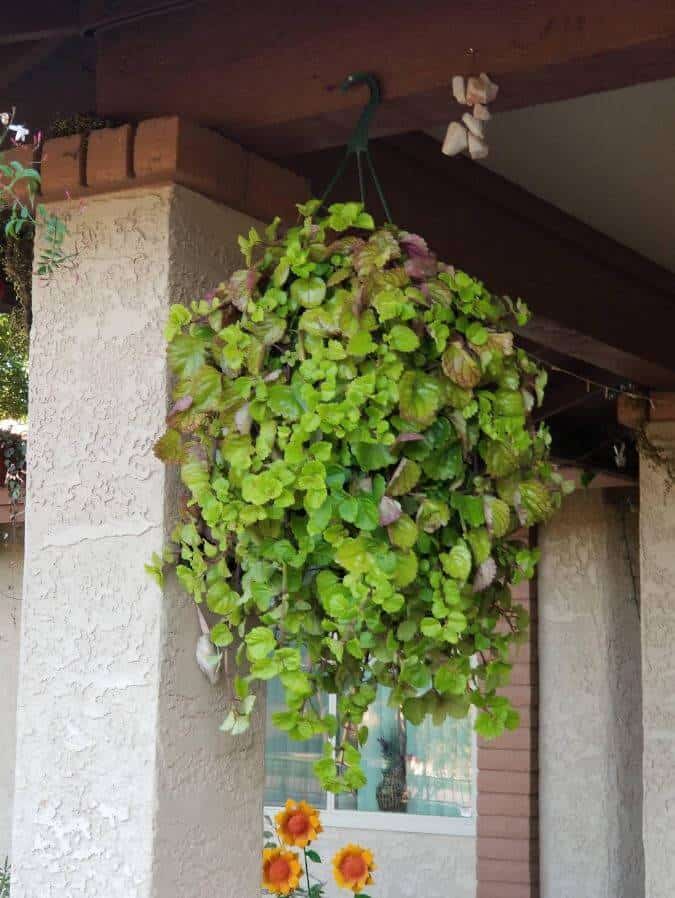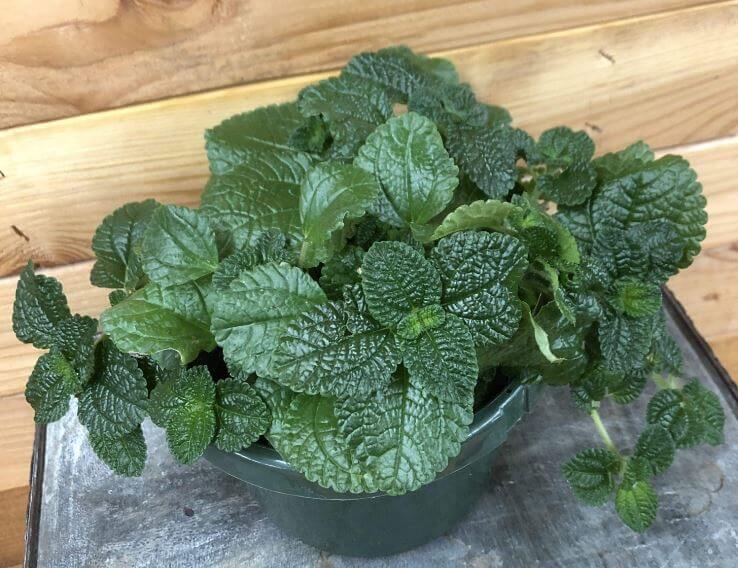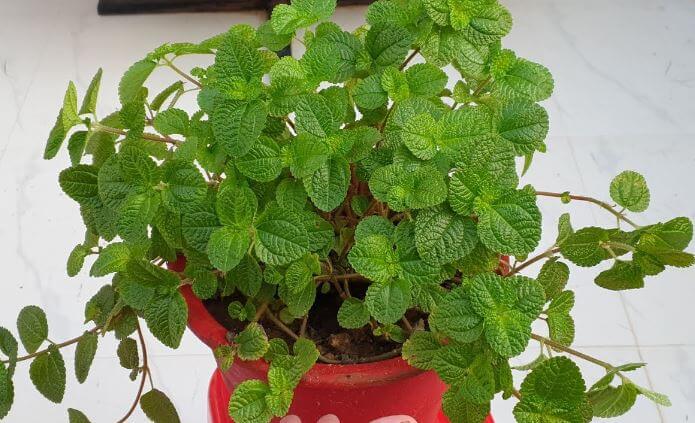Last Updated on March 20, 2023 by a Friendly Gardener
Native to the northern parts of South America and the West Indies, the Pilea nummulariifolia is better known as the Creeping Charlie Houseplant. Delightful when cultivated on a high shelf, in a hanging planter, or even in a terrarium, the Creeping Charlie gifts bright green leaves all year round.
Creeping Charlie, however, is also the name of another plant botanically named the Glechoma hederacea. These are two distinct plants that should not be confused. The difference lies in the fact that the latter can survive the winter outdoors, whereas the Pilea nummulariifolia is at home in the tropics. Our tropical Creeping Charlie may also appear under the names of Creeping Pilea or Swedish Ivy.
When cultivated outdoors in a warm climate this Pilea can be rather invasive, yet when cultivated in containers or as houseplants, they boast a rapid growth habit. In its native habitat of a tropical rainforest, it behaves as a ground cover, spreading easily and quickly. These plants ask very little of owners and are a happy choice for beginning gardeners.
Creeping Charlie Houseplant Care

This tropical rainforest native needs moist soil, and indirect sunlight, and should not be exposed to cooler environmental temperatures.
Soil
The Creeping Charlie houseplant does not do well in soggy soil, even if it requires consistent moisture. So, the growing medium should have good water retention capabilities yet excellent drainage to ensure root aeration. Soil pH should ideally measure between 6 and 7.5 or neutral to a bit acidic. If you wish to buy preblended potting soil, look for an African Violet soil blend. As an alternative, you can use peat-based potting soil and amend it with a fistful of perlite and a fistful of mature compost.
Light
The Creeping Charlie grows as a ground cover in its native habitat, so you will find it other a canopy of other vegetation. While some amount of sun will penetrate, it is dappled, filtered light. When raised as a houseplant, the light should be bright but indirect or filtered. Avoid direct sunlight. If your window receives harsh sunlight rays, move the plant back several feet.
Water

In its native habitat, Creeping Charlie needs consistently moist soil. Water your plant when the soil dries down to about an inch deep. Your plant may require watering a few times weekly. Water into the soil at the plant base to avoid getting foliage wet. Once the soil is evenly moistened, drain out excess water before returning your plant to its location.
Humidity
A good level of humidity for indoor cultivation is approximately 50% however levels ranging between 40% and 60% will be fine. If your indoor air is dry, use a space humidifier or a pebble tray with water placed below your plant’s container which should always sit above the water line. Other options include grouping plants to establish a microclimate or misting daily with collected rainwater or distilled water.
Feeding

Fertilizing the Creeping Charlie will keep its foliage lush and your plant healthy. If you amended soil with compost or added in a slow-release fertilizer when repotting, you won’t need to do any more feeding until the next repotting. If you did not add any organic matter or fertilizer, use a liquid plant fertilizer at half strength with an NPK of 10-10-10 or 3-1-2. Feed your plant immediately after watering during the growing season.
Pruning
As a rapid grower, your Charlie will need a trim occasionally to maintain its shape. Remove damaged or dying foliage and stems that appear unruly. Pinch off stem tips to stimulate bushier growth.
Repotting a Creeping Charlie Houseplant

Plan on repotting your Creeping Charlie Houseplant every two years due to its rapid growth habit. Watch for roots peeking from the soil bed or drainage holes. When they appear, it’s time to repot with a vase that is one size larger.
Creeping Charlie Houseplant Propagation
Creeping Charlies can be propagated through root division or with stem cuttings. When dividing root systems, during repotting separate the roots into separate clumps and repot them each in an individual container.
If you opt to use stem cuttings, remove a healthy stem section with a few leaves. Leave the leaves at the tip and remove any others. Put the cut stem ends into a jar of water or a tray with humid peat moss. Cover your cuttings with plastic to maintain humidity. Place in warm, indirect sunlight. Cuttings should root within a month.
Pests and Problems
The Creeping Charlie houseplant is not overly susceptible to pest infestations or diseases, but no houseplant is entirely immune. Examine your plant occasionally to look for evidence of pests visiting. Some sapsuckers enjoy feeding on this plant’s foliage. White or yellow specks on leaves may indicate spider mites as well as webbing underneath. Whiteflies are tiny flies that hide underneath leaves. For either, wash your plant down to remove them.
Mealybugs will leave cottony deposits and are best removed with cotton dipped in rubbing alcohol. After removing these bugs from your plant, treat them with insecticidal soap or Neem oil.
Overwatering can lead to the emergence of fungal infections or even bacterial diseases. Bacterial leaf spot (Xanthomonas Campestris) leaves spots that appear as if saturated. Remove infected leaves and treat them with a fungicide. Root rot will blacken roots turning them to mush while leaves will turn yellow. Remove the plant from its pot and trim away the affected roots. Repot in fresh, well-draining soil. Adjust your watering schedule.
Brown or black leaves indicate too much direct light exposure while leaf drop indicates that temperatures are too cool or there is a draft.
Is Creeping Charlie Houseplant Poisonous?
No, your Creeping Charlie plant is not poisonous to either humans or pets, making it an ideal choice for families with both children and fur or feather babies.
Creeping Charlie Houseplant Benefits

There are multiple health benefits identified with a Creeping Charlie, but in this case, these benefits refer to the Glechoma hederacea or Ground Ivy plant. It contains an impressive amount of vitamin C along with minerals like iron and copper. Expert herbalists recommend Creeping Charlie for coughs, bronchitis, or sinus congestion. It is used in both teas and tinctures.

